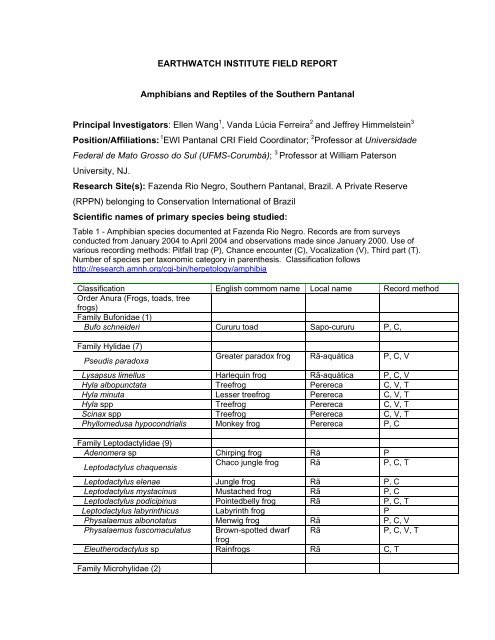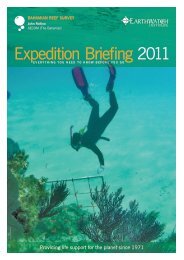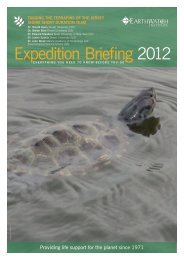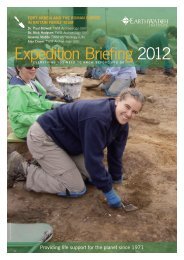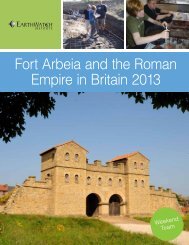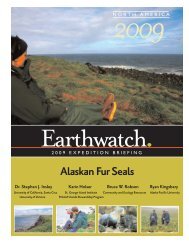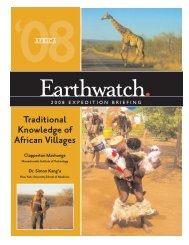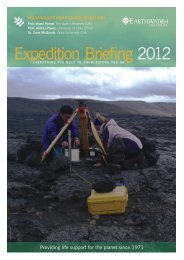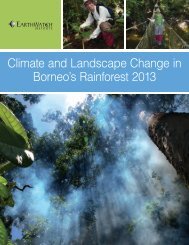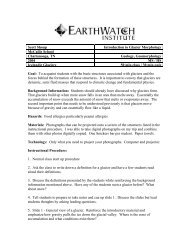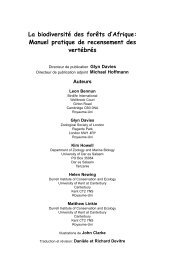EARTHWATCH INSTITUTE FIELD REPORT Amphibians and ...
EARTHWATCH INSTITUTE FIELD REPORT Amphibians and ...
EARTHWATCH INSTITUTE FIELD REPORT Amphibians and ...
You also want an ePaper? Increase the reach of your titles
YUMPU automatically turns print PDFs into web optimized ePapers that Google loves.
<strong>EARTHWATCH</strong> <strong>INSTITUTE</strong> <strong>FIELD</strong> <strong>REPORT</strong><br />
<strong>Amphibians</strong> <strong>and</strong> Reptiles of the Southern Pantanal<br />
Principal Investigators: Ellen Wang 1 , V<strong>and</strong>a Lúcia Ferreira 2 <strong>and</strong> Jeffrey Himmelstein 3<br />
Position/Affiliations: 1 EWI Pantanal CRI Field Coordinator; 2 Professor at Universidade<br />
Federal de Mato Grosso do Sul (UFMS-Corumbá); 3 Professor at William Paterson<br />
University, NJ.<br />
Research Site(s): Fazenda Rio Negro, Southern Pantanal, Brazil. A Private Reserve<br />
(RPPN) belonging to Conservation International of Brazil<br />
Scientific names of primary species being studied:<br />
Table 1 - Amphibian species documented at Fazenda Rio Negro. Records are from surveys<br />
conducted from January 2004 to April 2004 <strong>and</strong> observations made since January 2000. Use of<br />
various recording methods: Pitfall trap (P), Chance encounter (C), Vocalization (V), Third part (T).<br />
Number of species per taxonomic category in parenthesis. Classification follows<br />
http://research.amnh.org/cgi-bin/herpetology/amphibia<br />
Classification English commom name Local name Record method<br />
Order Anura (Frogs, toads, tree<br />
frogs)<br />
Family Bufonidae (1)<br />
Bufo schneideri Cururu toad Sapo-cururu P, C,<br />
Family Hylidae (7)<br />
Pseudis paradoxa<br />
Greater paradox frog Rã-aquática P, C, V<br />
Lysapsus limellus Harlequin frog Rã-aquática P, C, V<br />
Hyla albopunctata Treefrog Perereca C, V, T<br />
Hyla minuta Lesser treefrog Perereca C, V, T<br />
Hyla spp Treefrog Perereca C, V, T<br />
Scinax spp Treefrog Perereca C, V, T<br />
Phyllomedusa hypocondrialis Monkey frog Perereca P, C<br />
Family Leptodactylidae (9)<br />
Adenomera sp Chirping frog Rã P<br />
Leptodactylus chaquensis<br />
Chaco jungle frog Rã P, C, T<br />
Leptodactylus elenae Jungle frog Rã P, C<br />
Leptodactylus mystacinus Mustached frog Rã P, C<br />
Leptodactylus podicipinus Pointedbelly frog Rã P, C, T<br />
Leptodactylus labyrinthicus Labyrinth frog P<br />
Physalaemus albonotatus Menwig frog Rã P, C, V<br />
Physalaemus fuscomaculatus Brown-spotted dwarf<br />
frog<br />
Rã P, C, V, T<br />
Eleutherodactylus sp Rainfrogs Rã C, T<br />
Family Microhylidae (2)
Elachistocleis bicolor<br />
Chiasmocleis albopunctata White-spotted sheep<br />
frog<br />
Two-colored sheep frog Rã P<br />
Rã P<br />
Table 2 - Reptile species documented at Fazenda Rio Negro. Records are from surveys<br />
conducted from January 2004 to April 2004 <strong>and</strong> observations made since January 2000. Use of<br />
various recording methods: Pitfall trap (P), Chance encounter (C), Search (S), Third part (T).<br />
Number of species per taxonomic category in parenthesis. Classification follows http://www.emblheidelberg.de/~uetz/LivingReptiles.html<br />
Classification<br />
Order Chelonia (Turtles)<br />
Family Testudinidae (1)<br />
Local name Local name Record method<br />
Geochelone carbonaria<br />
Family Chelidae (1)<br />
Red-footed tortoise Jabuti C, T<br />
Acantochelys macrocephala Toad-headed turtle Cágado-do-<br />
Pantanal<br />
C, S, T<br />
Order Squamata<br />
Suborder Sauria (Lizards)<br />
Family Polychrotidae (1)<br />
Anolis sp<br />
Family Tropiduridae (1)<br />
Anole Papa-vento C, P<br />
Tropidurus guarani<br />
Family Gekkonidae (2)<br />
Neotropical ground lizard Calango C, T<br />
Coleodactylus brachistoma Gecko Lagartixa P<br />
Hemidactylus mabouia Common gecko Lagartixa-de- C, T<br />
parede<br />
Family Gymnophtalmidae (4)<br />
Vanzosaura rubricauda Orange-tailed forest lizard Rabinhovermelho-listrado<br />
P, C, T<br />
Micrablepharus maximiliani Blue-tailed forest lizard Rabinho-azul P, C, T<br />
Cercosaura ocellata Ocellated tegu -<br />
Cercosaura schreibersii Schreiber´s many -<br />
fingered teiid<br />
Family Scincidae (1)<br />
Mabuya sp<br />
Family Teiidae (4)<br />
Common skink Lagartixa-cobra P<br />
Ameiva ameiva Giant ameiva Calango-verde P, C, T<br />
Tupinambis merianae Tegu lizard Teiu C<br />
Dracaena paraguayensis Caiman lizard Víbora C<br />
Cnemidophorus ocellifer<br />
Family Amphisbaenidae (1)<br />
Spix’s whiptail -<br />
Amphisbaena sp Worm lizard Cobra-de-duascabeças<br />
P<br />
Suborder Serpentes (Snakes)<br />
Family Typhlopidae (1)<br />
Typhlops brongersmianus Typical blind snake Cobra-cega P<br />
Family Boidae (2)<br />
Boa constrictor Common boa Jibóia C, T<br />
Eunectes notaeus Yellow anaconda Sucuri C, T
Family Colubridae (20)<br />
Chironius flavolineatus Yellow lined vine snake Cobra-cipó-de<br />
cabeça-tijolo<br />
Chironius sp - Cobra-cipó C<br />
Echinanthera occipitalis - - C<br />
Helicops leopardinus Spotted water snake Cobra-d´águado-Pantanal<br />
C<br />
Hydrodynastes gigas False water cobra Jararacussu-dobrejo<br />
C, T<br />
Leptodeira annulata Cat-eyed snake Dormideira; Olhode-gato<br />
P, C, T<br />
Leptophis ahaetulla Parrot snake Azulão-bóia C, T<br />
Liophis typhlus Velvety swamp snake Jararaquinha- P, C, T<br />
verde<br />
Liophis poecilogyrus Swamp snake Cobra-de-lixo P, C, T<br />
Liophis meridionalis Lined ground snake Cobra-de-capim P, C, T<br />
Lystrophis matogrossensis Tricolored hognose snake Falsa-coral P, C, T<br />
Mastigodryas bifossatus Brown-lined snake Cascavel-do- C, T<br />
charco<br />
Oxyrhopus petola digitalis Blinded calico snake Falsa-coral P, C<br />
Phalotris sp Collared false coral snake Falsa-coral P<br />
Philodryas olfersii Palm snake Cobra-verde P, C, T<br />
Pseudoboa neuwiedii Eastern scarlet snake Falsa-coral P<br />
Pseudoeryx plicatilis Dusky mud snake Cobra-d´águalisa<br />
C, T<br />
Psomophis genimaculatus Spirit ground snake Cobra-de-capim P, C, T<br />
Sibynomorphus sp Bolivian tree snake Dormideira P, C, T<br />
Thamnodynastes sp House snake Jararaquinha-do-<br />
Pantanal<br />
C, T<br />
Family Viperidae (2)<br />
Bothrops neuwiedii Neuwied´s lancehead Boca-de-sapo C, T<br />
Crotalus durissis Neotropical rattlesnake Cascavel T<br />
Key Research Objectives:<br />
• To determine the diversity (richness <strong>and</strong> abundance) of amphibians <strong>and</strong> reptiles<br />
in the different habitats in the Southern Pantanal;<br />
• To investigate the ecology of the Pantanal turtles, the Pantanal Toad Headed<br />
Turtle (Acantochelys macrocephala) <strong>and</strong> the Red Foot Tortoise (Geochelone<br />
carbonaria);<br />
• To improve the knowledge base of teacher <strong>and</strong> student fellows, as well as<br />
volunteers but mainly the local community, concerning amphibians <strong>and</strong> reptiles,<br />
<strong>and</strong> to increase their degree of comfort <strong>and</strong> appreciation for h<strong>and</strong>ling nondangerous<br />
species.<br />
• Access the status of the populations of the amphibians <strong>and</strong> reptiles in the<br />
Southern Pantanal;<br />
• Support the design of conservation strategies for amphibians <strong>and</strong> reptiles in the<br />
Southern Pantanal;<br />
• Produce an Audio CD containing the frog calls;<br />
• Produce a field guide on amphibians <strong>and</strong> reptiles from the Southern Pantanal.
Date this report was completed: April 11 2005<br />
Data Collection <strong>and</strong> Results<br />
a) Give a concise account of the data you have collected during the past field<br />
season.<br />
• A total of 982 frogs from 13 species was captured in pitfall traps, marked <strong>and</strong><br />
released (24% in the dry season <strong>and</strong> 76% in the wet season).<br />
• The highest index of diversity for the anurofauna was observed in the Baias,<br />
during the dry season, <strong>and</strong> the lowest in Salinas during the rainy season.<br />
• Twenty–five snake species are known to occur at Fazenda Rio Negro, but<br />
only 10 species (33 individuals) were collected in the pitfall traps: 33.3% in<br />
dry season <strong>and</strong> 66.4% in the wet season.<br />
• One snake species not known to the area was trapped.<br />
• Thus far, 14 lizard species have been recorded for FRN. A total of 60<br />
individuals from 9 species was trapped (26 in the dry <strong>and</strong> 34 in the rainy<br />
season), being two arboreal species.<br />
• Twenty-three red-footed tortoises, Geochelone carbonaria (13 males <strong>and</strong> 9<br />
females) were captured, marked <strong>and</strong> released in 2004. Scat samples from<br />
several individuals were collected.<br />
• Thirteen toad-head turtles, Acantochelys macrocephala, (4 males <strong>and</strong> 9<br />
females) were collected: 9 in the dry season <strong>and</strong> 4 in the rainy season. Two<br />
newborns were trapped in pitfall traps near salinas. They were released<br />
without marking.<br />
b) What progress have you made towards achieving your original objectives?<br />
We have been able to detect slight differences in the frog community<br />
among the habitats were surveys have been conducted. However, more sampling <strong>and</strong><br />
data on environmental factors need to be matched in order to get a better picture on the<br />
distribution of species.<br />
A large number of good-quality photos of several species from the local<br />
herpetofauna has been taken. We hope to publish a photo field guide for amphibians<br />
<strong>and</strong> reptiles by the end of this research. A good recorder plus microphone have been<br />
purchased with EWI funds <strong>and</strong> a collection of frog calls is being recorded for future audio<br />
CD.
It seems obvious to us that more sampling effort is necessary for longterm<br />
monitoring studies on the herpetofauna, especially because populations from<br />
several frog species undergo natural fluctuations that are not detected unless frequently<br />
monitored. Also, we are not sure how the floods affect distribution of amphibians <strong>and</strong><br />
reptiles in the area.<br />
c) Please provide a summary of your results (even if they are preliminary).<br />
During the year of 2004, we surveyed amphibians <strong>and</strong> reptiles in three<br />
different habitats (Gallery Forest, Baías <strong>and</strong> Salinas) during the dry <strong>and</strong> rainy season in<br />
the Southern Pantanal. A total of 982 frogs from 13 species was captured in pitfall traps,<br />
marked <strong>and</strong> released. Highest frog abundance was observed in the Gallery Forest,<br />
followed by Baías <strong>and</strong> Salinas. In Baías <strong>and</strong> Salinas, Physalaemus albonotatus was the<br />
most abundant species <strong>and</strong> in Gallery Forest, it was Leptodactylus podicipinus, during<br />
both dry <strong>and</strong> rainy season. Twenty–five snake species are known to occur at Fazenda<br />
Rio Negro, but only 10 species (33 inviduals) were collected in the pitfall traps. Thus far,<br />
14 lizard species have been recorded for FRN. A total of 60 lizards from 9 species was<br />
trapped being two arboreal species. Twenty-three red-footed tortoises, Geochelone<br />
carbonaria (13 males <strong>and</strong> 9 females) were captured, marked <strong>and</strong> released in 2004. Scat<br />
samples from several individuals were collected.<br />
Significance/Benefits of Research<br />
a) What is/are the significance/benefits of your research at the following levels?<br />
• Local (in the area of the research site)<br />
1. At Fazenda Rio Negro, we have noticed a marked change in behavior of the local<br />
community as on of us (EW) has lived in the farm for a couple of years. Before<br />
we started the project, the workers naturally killed snakes whenever they came<br />
across one. But now, they even bring us snakes <strong>and</strong> are able to distinguish the<br />
poisonous from non-poisonous ones. When we first ran an expedition, lots of kids<br />
were in the farm <strong>and</strong> they were more curious than the adults. It was through the<br />
children that we reached the adults.<br />
2. Also, the neighboring farmers are interested about learning more about snakes<br />
because they believe snakes sometimes kill the cattle <strong>and</strong> horses. Whenever<br />
possible, we show visitors the snake <strong>and</strong> frog collection kept in the farm <strong>and</strong> it is<br />
rewarding to share our love <strong>and</strong> respect for such important animals.
• National<br />
1. One of us (Earthwatch) was on local <strong>and</strong> national TV programmes because two<br />
famous Brazilian actors filming a soap opera in the research site were learning<br />
about snakes <strong>and</strong> also helped in the field work.<br />
2. In November 2004, a newspaper article entitled “Turistas pagam para caçar<br />
sapos”. published in a Sunday edition of “ O Estado de São Paulo”, one of the<br />
most important periodicals in Brazil featured Earthwatch Institute <strong>and</strong> Volunteers,<br />
higlightling several projects, including the Herpetology Project. Ellen Wang <strong>and</strong><br />
V<strong>and</strong>a Lucia Ferreira were interviewed.<br />
• International<br />
Several fellow students, teachers, corporate workers, policy makers <strong>and</strong><br />
community members from different countries have participated our project <strong>and</strong> they<br />
take back to their communities the knowledge acquired during field work. They do<br />
not learn only about scientific methodology, but also to respect <strong>and</strong> protect natural<br />
resources. What they experience in the Pantanal is taken back to their original<br />
countries, <strong>and</strong> they become strongly engaged towards this new way of life <strong>and</strong><br />
therefore, contribute with the worldwide conservation of the environment.<br />
The Herpetology Project also tries to dismystify the fear for frogs <strong>and</strong> snakes<br />
most of the world population has. We allow volunteers to have a closer contact with<br />
animals by holding <strong>and</strong> photographing them. However, it is important to stress that<br />
nobody is forced to hold them, unless desired. Also, special precautions are taken<br />
concerning both non-poisonous <strong>and</strong> poisonous snakes <strong>and</strong> volunteers are not<br />
allowed to h<strong>and</strong>le species that represent any sort of danger, even those that are nonpoisonous<br />
but aggressive. Lots of other tasks are involved in the project <strong>and</strong><br />
volunteers do not necessarily need to deal directly with the specimens.<br />
b) How do your findings contribute to issues of sustainability?<br />
The data obtained by this research can be useful at different levels:<br />
• identification of environmentally impacted sites;<br />
• present evidence of impacts to l<strong>and</strong>owners, policy makers, <strong>and</strong> regional<br />
conservation organizations;
• identify & prioritize management actions to reduce impacts <strong>and</strong> restore degraded<br />
sites;<br />
• use sensitive indicator species to identify the onset of environmental impacts,<br />
e.g. related to pollution, fire, eutrophication, sedimentation, or climate change<br />
• use data to plan <strong>and</strong> implement biodiversity corridors;<br />
• provide data for biodiversity monitoring programs.<br />
Dissemination of Results<br />
a) Have you provided details of results from your research to or within:<br />
• Scientific papers<br />
Ferreira, V.L., Wang, E. & Himmelstein, J. 2005 . Geographic distribution. Phalotris<br />
nasutus. Herpetol. Review. (in press).<br />
• Management plans <strong>and</strong> reports (in progress or completed)<br />
Management plan for the Fazenda Rio Negro RPPN. Meeting between CI <strong>and</strong> several<br />
EW PIs in April 28-29, 2005 in Campo Gr<strong>and</strong>e, MS.<br />
• Presentations (given or planned)<br />
1. Mar. 2004: Presentation on the Herpetology Project at University of<br />
Pennsylvania. Speaker: Jeff Himmelstein. Undergraduate <strong>and</strong> graduate students<br />
<strong>and</strong> community members attended.<br />
2. Nov. 2004: Oral presentation: “<strong>Amphibians</strong> <strong>and</strong> Reptiles of Southern Pantanal”<br />
presented by V<strong>and</strong>a L. Ferreira, during the IV SINPAM (Symposium for the<br />
Natural, Social <strong>and</strong> Economical Resources in the Pantanal) organized by<br />
Embrapa in Corumbá, MS, Brazil, in. Participants: Ellen Wang <strong>and</strong> V<strong>and</strong>a Lucia<br />
Ferreira. Audience: Conservationists, undergraduate <strong>and</strong> graduate students,<br />
environmental agencies representatives, scientists.<br />
3. Nov. 2004: Annual EW conference, Boston, MA. CRI poster presented by Jeff<br />
Himmelstein.<br />
• Popular articles or films (in progress or completed)<br />
1. Nov. 2004: Newspaper article “Turistas pagam para caçar sapos”. Published in a<br />
Sunday edition of “ O Estado de São Paulo”, one of the most important<br />
periodicals in Brazil. The article was about Earthwatch Institute <strong>and</strong> Volunteers,
featuring several projects, including the Herpetology Project. Ellen Wang <strong>and</strong><br />
V<strong>and</strong>a Lucia Ferreira were interviewed.<br />
2. Nov/Dec 04, The Expeditioner: The Pantanal: Flooded with Life, by Ken Mallory.


